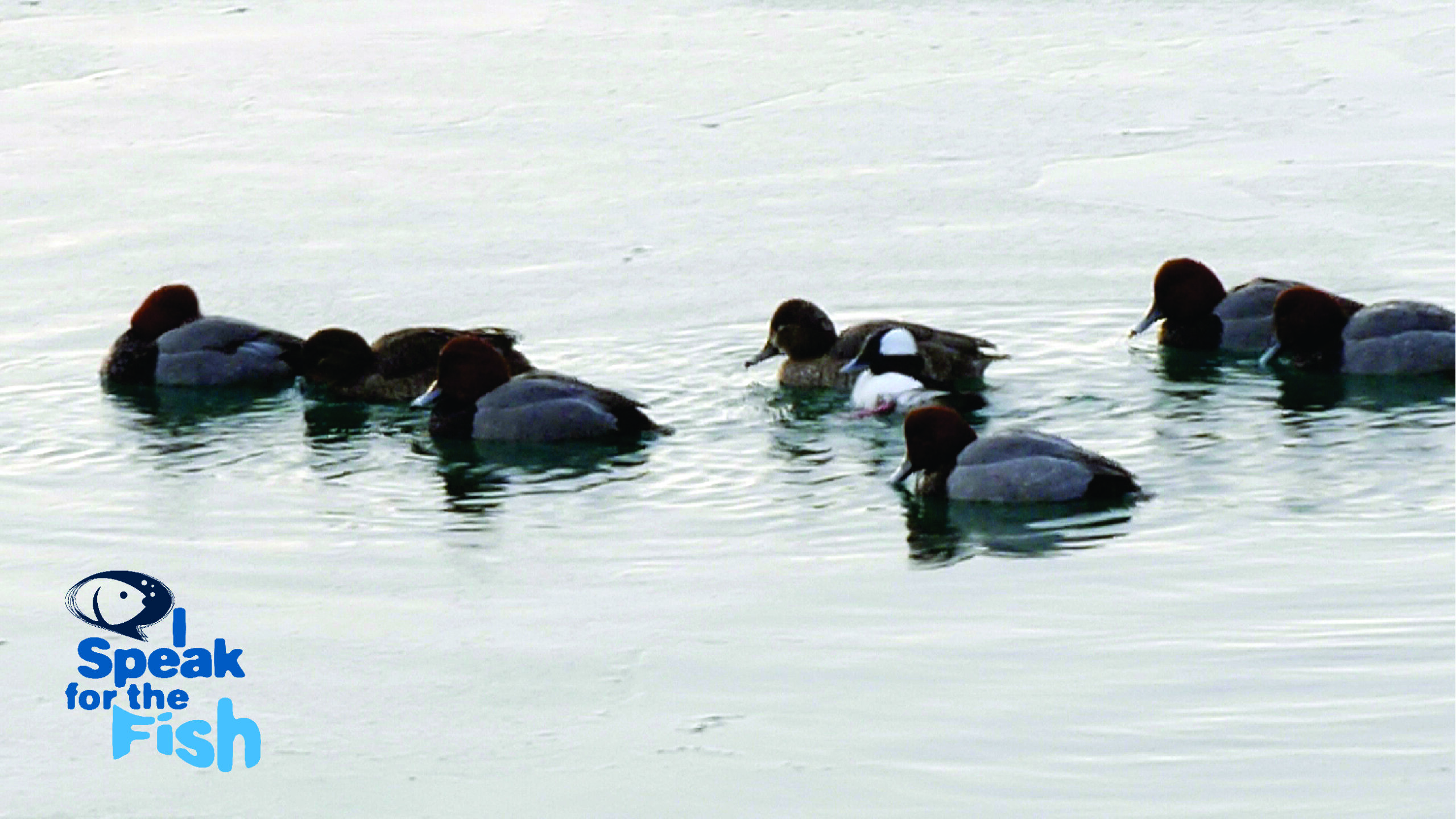
 I Speak for the Fish is a monthly column written by Great Lakes Now Contributor Kathy Johnson, coming out the third Monday of each month. Publishing the author’s views and assertions does not represent endorsement by Great Lakes Now or Detroit Public Television. Check out her previous columns.
I Speak for the Fish is a monthly column written by Great Lakes Now Contributor Kathy Johnson, coming out the third Monday of each month. Publishing the author’s views and assertions does not represent endorsement by Great Lakes Now or Detroit Public Television. Check out her previous columns.
“How are they doing it?” I pondered aloud.
“No idea,” my husband replied.
We watched in silence as another raft of diving ducks moved into a straight line. The leader executed a flawless surface dive and the team of redheads followed in perfect secession. Their timing rivaled the best synchronized swim teams.
When a group of long-tails dove, we scanned the water trying to anticipate where they would surface.
Unlike their departure, they popped up with disorderly exuberance like kernels of corn bursting from a hot pan. We did not need binoculars to see a fish’s tail trailing from one of the duck’s bills.
After each dive, at least one duck in each group surfaced with a fish. Occasionally, two members of the raft returned with a fresh meal. From the size, shape and color of the parts we could see, they were feasting on round gobies.
The bottom of the St. Clair River, where the round gobies live was 20 feet down beneath an unrelenting current. Nearly twice as much water was flowing under the ducks’ feet than the amount flowing over Niagara Falls most days. Yet, the ducks had no problem maintaining position in the river or making the 20-foot dive.
Impressive indeed. But what really had us scratching our heads was the ease with which they seemed to be retrieving gobies.
Because the last time we checked, there were no gobies swimming around down there.

Long-tails. (Photo Credit: Greg Lashbrook/PolkaDot Perch)
Winter vacation
In the Great Lakes, fish move with the seasons.
In the summertime, the water beneath the ducks is bustling with dozens of different fish species including four kinds of bass, two types of darters, two different perches, two types of trout, three kinds of suckers, half a dozen different catfish, plus burbot, goby, shad, sheepshead, stickleback, muskellunge and walleye.
Spring and fall at the same site features all of the above with the likelihood of also seeing lake sturgeon, salmon, or steelhead.
In sharp contrast, wintertime at the site is like an aquatic desert seemingly barren of life.
There are not just fewer fish. It seems like there are no fish. It is common to make a winter dive here and never see a finned friend. Well, maybe one lone walleye off in the distance.
But no round goby. We knew this because we had already spent dozens of dives looking for them.
When round gobies were discovered in the Great Lakes, we worked with researchers at the University of Michigan who were studying their impact. Our role was primarily to locate the new invasive species underwater.
Finding gobies in the summer is easy but once winter sets in, they disappeared. And no one knew for sure where they all went.
They were not hiding under logs or other river debris. We checked the shallows, the depths and everywhere in between. We thought we left no stone unturned.
We figured the gobies left this area just like the bass and perch do. Where all the fish go is the topic of a future column.
But if the gobies left with the other fish, how was it possible that in the middle of January, every few minutes another duck popped to the surface with a goby in its mouth?
We had to find out.

Under the ice. (Photo Credit: Greg Lashbrook/PolkaDot Perch)
Goby quest
Most people assume the worst part of winter diving is jumping into ice cold water. In reality, feeling cold is the least of the issues winter divers face. Modern drysuits and thermal underwear are capable of keeping us toasty warm. A lot of drysuit divers even come up sweating.
The problem is not the diver freezing, it is everything else.
Frozen water in the form of icesheets, flows and bergs can quickly trap and kill a diver. Equipment failures caused by the extreme cold such as a regulator freezing open can have deadly consequences. While ladder rungs, handrails and sidewalks all become incredibly hazardous for a dripping wet diver in the winter.
As expected, when Greg and I entered the water, we weren’t greeted by any inquisitive yellow perch or territorial largemouth bass. No schools of emerald shiners swam overhead as we descended to the 20-foot mark.
There was not a round goby in sight.
We knew they had to be here somewhere, and we were determined to find them. Every log was rolled, every budgeable rock was moved. We looked under chunks of concrete and inside old tires. We found no gobies. This was not the first time we had been outsmarted by ducks. But we were not giving up. There was still one spot to check. It seemed completely inaccessibly to gobies and ducks but it was the only place we hadn’t looked.
Moving heavy objects underwater is often easier than on land. I always feel herculean when I’m able to lift a rock underwater that I would struggle to roll in my garden. But even with Archimedes principal working in my favor, some stones are just too big for me to budge.
Greg pointed to one of these unmovable rocks. Working together, we loosened the river’s grip on the stone by fanning away the river bottom on one side. It took some excavating, but we were finally able to dislodge the massive rock. River water immediately swirled into the newly uncovered depression on the bottom.
Our eyes strained to focus as the swirling sand slowly dispersed.
I was still scanning for any signs of life when Greg pointed to a spot directly in front of me. I squinted at the smooth speckled sand bottom knowing there must be something…
Suddenly, I realized that two perfectly symmetrical black dots were not identical grains of sand. They were eyeballs!
The gobies had completely buried themselves in the sand leaving just the tiniest bit of their eyes visible. The closer I looked, the more pairs of eyes I saw. There were easily a dozen gobies hiding under this one rock.
Gobies can drop into a state of dormancy without needing to eat. This allows them to spend long periods of time – like most of the winter – buried on bottom.
They were so listless that we could pick them up by their tails.
The rock they were hiding under had been deeply seated in the river bottom for a very long time. We had checked the perimeter prior to moving it and found no evidence of any access tunnels or burrows.
But gobies are good burrowers.
It’s no problem for them to burrow down into the river bottom without leaving a trace behind. While impressive, it’s not clever enough to best the ducks.
We later discovered the ducks’ technique for accessing the gobies was far more efficient than ours. They often work in teams with some flipping over rocks and others grabbing the fishes that dart out. And they may even excavate small access tunnels under larger rocks and then take turns sticking in their heads and plucking out the gobies.
Ducks, particularly the divers, never fail to amaze me. If not for them routinely returning with a fresh kill, I’m not sure we ever would have figured out where the gobies were hiding in the winter.
Catch more news at Great Lakes Now:
I Speak for the Fish: Courting Sunfish
I Speak for the Fish: And the survey says…
Featured image: Diving ducks. (Photo Credit: Greg Lashbrook/PolkaDot Perch)
6 Comments
-
What an impressive and fun recounting of discovery — by you and by the ducks. I wish there were videos but still, thanks for a great article!
-
Well done Kathy. Fun story. Keep up the good work!
-
Were the redheads eating gobies, or just the long-tails? Thanks! and thanks for another GREAT article
-
Hi Dan, Thanks! Glad you enjoyed it and thanks for reading!
-
Thanks, Mike. Glad you enjoyed it!
-
Hi Ed, we’ve only seen and filmed the long-tails with gobies. Thanks for commenting!




